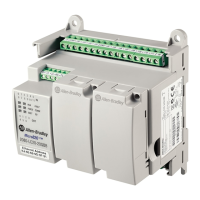Rockwell Automation Publication PFLEX-AT001L-EN-P - September 2017 11
Chapter 2
Determining Dynamic Brake Requirements
How to Determine Dynamic
Brake Requirements
When a drive is consistently operating in the regenerative mode of operation,
serious consideration should be given to equipment that transforms the electrical
energy back to the fixed frequency utility grid.
As a rule, Dynamic Braking can be used when the need to dissipate regenerative
energy is on an occasional or periodic basis. In general, the motor power rating,
speed, torque, and details regarding the regenerative mode of operation are
needed to estimate what Dynamic Brake Resistor value is needed.
The Peak Regenerative Power and Average Regenerative Power that is
required for the application must be calculated to determine the resistor that is
needed for the application. Once these values are determined, the resistors can be
chosen. If an internal resistor is chosen, the resistor must be capable of handling
the regenerated power or the drive will trip. If an external resistor is chosen, in
addition to the power capabilities, the resistance must also be less than the
application maximum and greater than the drive minimum or the drive will trip.
The power rating of the Dynamic Brake Resistor is estimated by applying what is
known about the drive’s motoring and regenerating modes of operation. The
Average Power Dissipation must be estimated and the power rating of the
Dynamic Brake Resistor that is chosen to be greater than that average. If the
Dynamic Brake Resistor has a large thermodynamic heat capacity, then the
resistor element will be able to absorb a large amount of energy without the
temperature of the resistor element exceeding the operational temperature rating.
Thermal time constants in the order of 50 seconds and higher satisfy the criteria
of large heat capacities for these applications. If a resistor has a small heat capacity
(defined as thermal time constants less than 5 seconds) the temperature of the
resistor element could exceed its maximum.
Peak Regenerative Power can be calculated as:
• Horsepower (English units)
• Watts (The International System of Units, SI)
• Per Unit System (pu) which is relative to a value
The final number must be in watts of power to estimate the resistance value of the
Dynamic Brake Resistor. The following calculations are demonstrated in SI units.
Gather the Following Information
• Power rating from motor nameplate in watts, kilowatts, or horsepower

